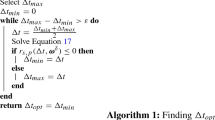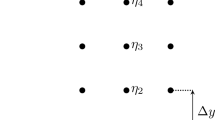Abstract
We conduct a comparative study of the Jacobian-free linearly implicit Rosenbrock–Wanner (ROW) methods, the explicit first stage, singly diagonally implicit Runge–Kutta (ESDIRK) methods, and the second-order backward differentiation formula (BDF2) for the high-order flux reconstruction/correction procedure via reconstruction solution of the unsteady Navier–Stokes equations. Pseudo-transient continuation is employed to solve the nonlinear equation at each stage of ESDIRK (excluding the first stage) and each step of BDF2. A Jacobian-free implementation of the restarted generalized minimal residual method solver is employed with a low storage element-Jacobi preconditioner to solve the linear system at each stage of ROW and each pseudo time iteration of ESDIRK and BDF2. Several numerical experiments, including both laminar and turbulent flow simulations, are conducted to carry out the comparison. We observe that the multistage ROW2 and ESDIRK2 are more efficient than the multistep BDF2, and higher-order implicit time integrators are more efficient than lower-order ones. In general, the ESDIRK method allows a larger physical time step size for unsteady flow simulation than the ROW method when the element-Jacobi preconditioner is employed, especially for wall-bounded flows; and the ROW method can be more efficient than the ESDIRK method when the time step size is refined.








Similar content being viewed by others
References
Cockburn, B., Shu, C.-W.: TVB Runge-Kutta local projection discontinuous Galerkin finite element method for conservation laws II: general framework. Math. Comput. 52, 411–435 (1989)
Bassi, F., Rebay, S.: A high-order accurate discontinuous finite element method for the numerical solution of the compressible Navier–Stokes equations. J Comput Phys 131(2), 267–279 (1997)
Hesthaven, J.S., Warburton, T.: Nodal Discontinuous Galerkin Methods: Algorithms, Analysis, and Applications. Springer, New York (2008)
Huynh, H.T.: A flux reconstruction approach to high-order schemes including discontinuous Galerkin methods. In: The 18th AIAA Computational Fluid Dynamics Conference, (Miami, FL), AIAA-2007-4079 (2007)
Huynh, H.T.: A reconstruction approach to high-order schemes including discontinuous Galerkin methods for diffusion. In: The 47th AIAA Aerospace Sciences Meeting including The New Horizons Forum and Aerospace, (Orlando, FL), AIAA-2009-403 (2009)
Wang, Z.J., Gao, H.Y.: A unifying lifting collocation penalty formulation including the discontinuous Galerkin, spectral volume/difference methods for conservation laws on mixed grids. J. Comput. Phys. 228, 8161–8186 (2009)
Vincent, P.E., Castonguay, P., Jameson, A.: A new class of high-order energy stable flux reconstruction schemes. J. Sci. Comput. 47, 50–72 (2011)
Bassi, F., Crivellini, A., Rebay, S., Savini, M.: Discontinuous Galerkin solution of the Reynolds-averaged Navier–Stokes and \(k--\omega \) turbulence model equations. Comput. Fluids 34, 507–540 (2005)
Liang, C., Premasuthana, S., Jameson, A., Wang, Z.J.: Large eddy simulation of compressible turbulent channel flow with spectral difference method. In: 47th AIAA Aerospace Sciences Meeting including The New Horizons Forum and Aerospace Exposition, AIAA-2009-402, (2009)
Uranga, A., Persson, P.O., Drela, M., Peraire, J.: Implicit large eddy simulation of transition to turbulence at low Reynolds numbers using a discontinuous Galerkin method. Int. J. Numer. Methods Eng. 87, 232–261 (2011)
Bassi, F., Botti, L., Colombo, A., Crivellini, A., Ghidoni, A., Massa, F.: On the development of an implicit high-order discontinuous Galerkin method for DNS and implicit LES of turbulent flows. Eur. J. Mech.-B/Fluids 55, 367–379 (2016)
Ceze, M.A., Fidkowski, K.J.: High-order output-based adaptive simulations of turbulent flow in two dimensions. AIAA J. 54, 2611–2625 (2016)
Wang, Z.J., Li, Y., Jia, F., Laskowski, G.M., Kopriva, J., Paliath, U., Bhaskaran, R.: Towards industrial large eddy simulation using the FR/CPR method. Comput. Fluids 156, 579–589 (2017)
Park, J.S., Witherden, F.D., Vincent, P.E.: High-order implicit large-eddy simulations of flow over a NACA0021 aerofoil. AIAA J. 55, 2186–2197 (2017)
Ahrabi, B.R., Brazell, M.J., Mavriplis, D.J.: An investigation of continuous and discontinuous finite-element discretizations on benchmark 3D turbulent flows. In 2018 AIAA aerospace sciences meeting, AIAA-2018-1569 (2018)
Gottlieb, S., Shu, C.-W., Tadmor, E.: Strong stability-preserving high-order time discretization methods. SIAM Rev. 43(1), 89–112 (2001)
Yang, H., Li, F., Qiu, J.: Dispersion and dissipation errors of two fully discrete discontinuous Galerkin methods. J. Sci. Comput. 55, 552–574 (2013)
Vermeire, B., Vincent, P.: On the behaviour of fully-discrete flux reconstruction schemes. Comput. Methods Appl. Mech. Eng. 315, 1053–1079 (2017)
Alhawwary, M., Wang, Z.: Fourier analysis and evaluation of DG, FD and compact difference methods for conservation laws. J. Comput. Phys. 373, 835–862 (2018)
Wanner, G., Hairer, E.: Solving Ordinary Differential Equations II. Springer, Berlin (1996)
Bijl, H., Carpenter, M.H., Vatsa, V.N., Kennedy, C.A.: Implicit time integration schemes for the unsteady compressible Navier–Stokes equations: laminar flow. J. Comput. Phys. 179(1), 313–329 (2002)
Carpenter, M.H., Viken, S.A., Nielsen, E.J.: The efficiency of high order temporal schemes. In: AIAA Paper, vol. 86 (2003)
Wang, L., Mavriplis, D.J.: Implicit solution of the unsteady euler equations for high-order accurate discontinuous Galerkin discretizations. J. Comput. Phys. 225(2), 1994–2015 (2007)
Cash, J.: On the integration of stiff systems of ODEs using extended backward differentiation formulae. Numer. Math. 34(3), 235–246 (1980)
Voss, D.A., Casper, M.J.: Efficient split linear multistep methods for stiff ordinary differential equations. SIAM J. Sci. Stat. Comput. 10(5), 990–999 (1989)
Psihoyios, G.-Y., Cash, J.: A stability result for general linear methods with characteristic function having real poles only. BIT Numer. Math. 38(3), 612–617 (1998)
Psihoyios, G.: A general formula for the stability functions of a group of implicit advanced step-point (IAS) methods. Math. Comput. Model. 46(1–2), 214–224 (2007)
Nigro, A., Ghidoni, A., Rebay, S., Bassi, F.: Modified extended BDF scheme for the discontinuous Galerkin solution of unsteady compressible flows. Int. J. Numer. Methods Fluids 76(9), 549–574 (2014)
Nigro, A., De Bartolo, C., Bassi, F., Ghidoni, A.: Up to sixth-order accurate A-stable implicit schemes applied to the discontinuous Galerkin discretized Navier–Stokes equations. J. Comput. Phys. 276, 136–162 (2014)
Butcher, J.C.: Numerical Methods for Ordinary Differential Equations. Wiley, Chichester (2002)
Jameson, A.: Time dependent calculations using multigrid, with applications to unsteady flows past airfoils and wings. In 10th Computational Fluid Dynamics Conference, p. 1596 (1991)
Jameson, A.: Evaluation of fully implicit Runge Kutta schemes for unsteady flow calculations. J. Sci. Comput. 73(2–3), 819–852 (2017)
Kennedy, C.A., Carpenter, M.H.: Diagonally Implicit Runge-Kutta Methods for Ordinary Differential Equations. A Review. Tech. Rep. NASA/TM–2016–219173, NASA (2016)
Baker, A.J., Iannelli. G.S.: A stiffly-stable implicit Runge-Kutta algorithm for CFD applications. In: 26th AIAA Aerospace Sciences Meeting, AIAA Paper 88-0416 (1988)
Lang, J., Verwer, J.: ROS3P—an accurate third-order Rosenbrock solver designed for parabolic problems. BIT Numer. Math. 41(4), 731–738 (2001)
Rang, J., Angermann, L.: New Rosenbrock W-methods of order 3 for partial differential algebraic equations of index 1. BIT Numer. Math. 45(4), 761–787 (2005)
Rang, J.: An analysis of the Prothero–Robinson example for constructing new DIRK and ROW methods. J. Comput. Appl. Math. 262, 105–114 (2014)
Steinebach, G.: Order-reduction of ROW-methods for DAEs and method of lines applications. Preprint/Fachbereich Mathematik, Technische Hochschule Darmstadt, vol. 1741 (1995)
Tranquilli, P., Sandu, A.: Rosenbrock–Krylov methods for large systems of differential equations. SIAM J. Sci. Comput. 36(3), A1313–A1338 (2014)
Rang, J.: Improved traditional Rosenbrock–Wanner methods for stiff ODEs and DAEs. J. Comput. Appl. Math. 286, 128–144 (2015)
Bassi, F., Botti, L., Colombo, A., Ghidoni, A., Massa, F.: Linearly implicit Rosenbrock-type Runge-Kutta schemes applied to the discontinuous Galerkin solution of compressible and incompressible unsteady flows. Comput. Fluids 118, 305–320 (2015)
Liu, X., Xia, Y., Luo, H., Xuan, L.: A comparative study of Rosenbrock-type and implicit Runge-Kutta time integration for discontinuous Galerkin method for unsteady 3D compressible Navier–Stokes equations. Commun. Comput. Phys. 20(4), 1016–1044 (2016)
Franciolini, M., Crivellini, A., Nigro, A.: On the efficiency of a matrix-free linearly implicit time integration strategy for high-order discontinuous Galerkin solutions of incompressible turbulent flows. Comput. Fluids 159, 276–294 (2017)
Wang, L., Yu, M.: On the parallel implementation and performance study of high-order Rosenbrock-type implicit Runge–Kutta methods for the FR/CPR solutions of the Navier–Stokes equations. In: 2018 AIAA Aerospace Sciences Meeting, AIAA-2018-1095 (2018)
Blom, D.S., Birken, P., Bijl, H., Kessels, F., Meister, A., van Zuijlen, A.H.: A comparison of Rosenbrock and ESDIRK methods combined with iterative solvers for unsteady compressible flows. Adv. Comput. Math. 42(6), 1401–1426 (2016)
Sarshar, A., Tranquilli, P., Pickering, B., McCall, A., Roy, C.J., Sandu, A.: A numerical investigation of matrix-free implicit time-stepping methods for large CFD simulations. Comput. Fluids 159, 53–63 (2017)
Persson, P.-O., Peraire, J.: Newton-GMRES preconditioning for discontinuous Galerkin discretizations of the Navier–Stokes equations. SIAM J. Sci. Comput. 30, 2709–2733 (2008)
Roe, P.L.: Approximate Riemann solvers, parameter vectors and difference schemes. J. Comput. Phys. 43, 357–372 (1981)
Gao, H., Wang, Z., Huynh, H.: Differential formulation of discontinuous Galerkin and related methods for the Navier–Stokes equations. Commun. Comput. Phys. 13(4), 1013–1044 (2013)
Mulder, W.A., Van Leer, B.: Experiments with implicit upwind methods for the Euler equations. J. Comput. Phys. 59(2), 232–246 (1985)
Knoll, D.A., Keyes, D.E.: Jacobian-free Newton–Krylov methods: a survey of approaches and applications. J. Comput. Phys. 193(2), 357–397 (2004)
Balay, S., Abhyankar, S., Adams, M.F., Brown, J., Brune, P., Buschelman, K., Dalcin, L., Eijkhout, V., Gropp, W.D., Kaushik, D., Knepley, M.G., McInnes, L.C., Rupp, K., Smith, B.F., Zampini, S., Zhang, H., Zhang, H.: PETSc users manual. Tech. Rep. ANL-95/11-Revision 3.7, Argonne National Laboratory (2016)
Sharov, D., Luo, H., Baum, J., Löhner, R.: Implementation of unstructured grid GMRES+LU-SGS method on shared-memory, cache-based parallel computers. In: 38th Aerospace Sciences Meeting and Exhibit, p. 927 (2000)
Franciolini, M., Botti, L., Colombo, A., Crivellini, A.: \(p\)-Multigrid matrix-free discontinuous Galerkin solution strategies for the under-resolved simulation of incompressible turbulent flows (2018). arXiv:1809.00866
Wang, L., Yu, M.: An Implicit high-order preconditioned flux reconstruction method for low-mach-number flow simulation with dynamic meshes. Int. J. Numer. Methods Fluids 91, 348–366 (2019)
Van Rees, W.M., Leonard, A., Pullin, D., Koumoutsakos, P.: A comparison of vortex and pseudo-spectral methods for the simulation of periodic vortical flows at high reynolds numbers. J. Comput. Phys. 230(8), 2794–2805 (2011)
Wang, Z.J., Fidkowski, K., Abgrall, R., Bassi, F., Caraeni, D., Cary, A., Deconinck, H., Hartmann, R., Hillewaert, K., Huynh, H.T., Kroll, N., May, G., Persson, P.O., van Leer, B., Visbal, M.: High order CFD methods: current status and perspective. Int. J. Numer. Methods Fluids 72, 811–845 (2013)
Beck, A.D., Bolemann, T., Flad, D., Frank, H., Gassner, G.J., Hindenlang, F., Munz, C.-D.: High-order discontinuous Galerkin spectral element methods for transitional and turbulent flow simulations. Int. J. Numer. Methods Fluids 76(8), 522–548 (2014)
Galbraith, M., Visbal, M.: Implicit large eddy simulation of low Reynolds number flow past the SD7003 airfoil. In: 46th AIAA Aerospace Sciences Meeting and Exhibit, p. 225 (2008)
Selig, M.S.: Summary of low speed airfoil data, vol. 1. SoarTech Publications, Virginia Beach (1995)
Acknowledgements
The authors gratefully acknowledge the support of the Office of Naval Research through the award N00014-16-1-2735, and the faculty startup support from the department of mechanical engineering at the University of Maryland, Baltimore County (UMBC). The hardware used in the computational studies is part of the UMBC High Performance Computing Facility (HPCF). The facility is supported by the U.S. National Science Foundation through the MRI program (Grant Nos. CNS-0821258, CNS-1228778, and OAC-1726023) and the SCREMS program (Grant No. DMS-0821311), with additional substantial support from UMBC.
Author information
Authors and Affiliations
Corresponding author
Additional information
Publisher's Note
Springer Nature remains neutral with regard to jurisdictional claims in published maps and institutional affiliations.
Rights and permissions
About this article
Cite this article
Wang, L., Yu, M. Comparison of ROW, ESDIRK, and BDF2 for Unsteady Flows with the High-Order Flux Reconstruction Formulation. J Sci Comput 83, 39 (2020). https://doi.org/10.1007/s10915-020-01222-z
Received:
Revised:
Accepted:
Published:
DOI: https://doi.org/10.1007/s10915-020-01222-z




